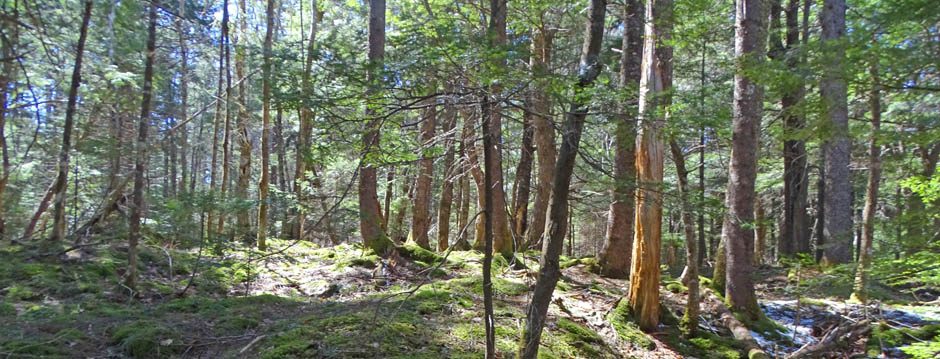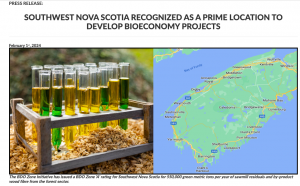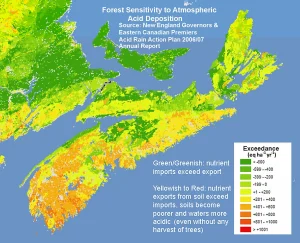This latest “Bioeconomy” initiative would involve use of 550,000 green metric tons per year of sawmill residuals and by-product wood fibre from the forest sector. In the formal BDO Zone Report, cautions are expressed that are not amongst the highlights cited in PR lit about about the Bioeconomy prospects for SW Nova Scotia and presumably are amongst the reasons that a higher rating (AAA or AA versus the A-rating given) was not realized, e.g. related to nutrient limitations, uncertainty about buy-in of private woodlot owners, sustainability concerns and associated public opinion. The concept in NS goes back to Dexter NDP Days and dreams of “Cellufuel” and other biorefinery products replacing the markets for residuals and low grade wood lost with closure of the Bowater Mill; now we have the loss of the NP Mill contributing further to supply, and advocates are able to cite the harmony/sustainability created by the Lahey Report/implementation of the forest Triad as a supporting factor in development of a regional Bioeconomy. I am concerned that our federal, provincial, and municipal governments are more easily sold – or “oversold” – on the Bioeconomy prospects than is private industry (shades of Cellufuel) and that pressures will be applied by Big Forestry on the NS government to reduce perceived government restrictions on development of the Bioeconomy and to otherwise facilitate heavy reliance on Crown lands. There is clearly a need and significant opportunities for use of the forest residuals, but also needed is a dose of realism about what is actually desirable and truly sustainable economically, ecologically and socially in SW Nova Scotia.
For details of the A-rating/Bioeconomy Opportunities in SW Nova Scotia, view:
(i) Southwest Nova Scotia recognized as a prime location to develop Bioeconomy projects
Joint Press Release by Ecostrat, BDO Zone Intitiative & Greenspring Bioinnovation Hub issued Feb 1, 2024;
The BDO Zone encompasses a 150 km radius, centered around Caledonia, NS, and includes four strategically located sites within 150 km of the Port of Halifax, ideal for bio-project development. The Zone is anchored by excellent infrastructure with several industrial parks, validated interest from local wood fibre generator Freeman Lumber to support new bio-based projects, a large mechanized contractor base, strong access to ocean transport, along with world-class ecological forestry practices on Crown land, ensuring sustainable wood supply.
“Beyond traditional products like lumber and paper, there is lots of potential for Nova Scotia’s forestry sector to use sustainably harvested wood fibre to create new wood-based products like biofuels, wood pellets and briquettes, and much more,” said Tory Rushton, Minister of Natural Resources and Renewables, Nova Scotia.
(ii) BDO Zone Designation: Southwest Nova Scotia | BDO Zone Rating: ‘A’
BDO Zone Report, Final document dated 2024-01-26. Detailed; 62 pages.
The Report highlights as major BDO Zone Assets:
• 550,000 GMT/yr of woody biomass potentially available for new projects
• A large sawmill that has recently expanded woodland and milling operations
• A mechanized contractor base with experience producing the rated quantity of roundwood
• Ecological forestry regulations ensure sustainable wood supply from public lands
• Four sites suitable for bio-project development within 150 km of the Port of Halifax
The Report highlights as BDO Zone Liabilities
• Significant trucking capacity shortages
• Road weight restrictions and diesel price trends introduce transport cost risk
• Increased partial harvesting and protected area coverage increase wood supply costs
Also notable jn my view are the following comments which raise real issues not highlighted in the PR summaries, and are presumably part of the basis for the ‘A” rating versus higher possible ratings (AAA, AA); bolding/italics below are inserted:
The forest industry in the region is well developed, with established milling and logging infrastructure, an experienced workforce, and public support for, and tolerance of, forestry and trucking operations. Over a dozen governmental and non-profit organizations are actively collaborating with industry to develop the forest sector.
Land ownership structures and provincial regulations relevant to biomass supply constitute another elevated risk. Roundwood sourced from smaller private woodlots could comprise as much as 60% of total wood fibre supply for a new project. Many forestry professionals contacted by Ecostrat expressed concern over changes in the willingness of small private landowners to harvest. Others were more optimistic about potential wood supply from smaller woodlots. The situation is mitigated to some extent by the presence of private and non-profit organizations that connect and mediate with private landowners…
In the longer term (e.g., >5 years), an expected increase in partial harvesting and protected area prevalence in SW NS adds further uncertainty to wood supply from public lands…
The severe nutrient depletion of soils of SW Nova Scotia due to a combination of acid rain and naturally thin soils on resistant bedrock was recognized in the mid-2000s and raised concerns then about sustainability of anticipated forest biomass harvesting. View Calcium Depletion and subpages on nsforestnotes.ca
Conversely, wood supply from private lands over the long-term may be adversely affected by forest harvest practices on some sites. Many areas of SW NS have shallow, acidic soils that are vulnerable to repeated biomass removal. Although partial harvesting on private lands has increased since the 1980s, over 50% of all harvesting on private lands in SW NS still involves clearcutting. The rated quantity of roundwood (400,000 GMT/yr) is expected to account for potential nutrient budget deficiencies, as it constitutes 75% of the total sustainable annual wood supply (Appendix B). This issue was assessed as a low-to-moderate risk to the rated quantity of biomass, but sustainability concerns and associated public opinion are noteworthy.
THE SPONSORS/ADVOCATES
1. Ecostrat is self described as “Biomass Feedstock Supply | Superior Supply Chain Intelligence ® | US & Canada”.
2 The BDO (Bioeconomy Development Opportunity) Zone Initiative appears to be mainly US- and Canada-based. “The BDO Zone Initiative is a certification and regional risk rating program that enables economic development agencies and communities to effectively and credibly disclose feedstock and infrastructure attributes and risks and promote biobased development opportunities to developers and investors around the world. A BDO Zone rating is a technical, standards-based assessment of regional manufacturing readiness with respect to local development potential for biofuel, renewable chemical, biogas or bio-product plants.‘AAA’, ‘AA’, ‘A’ and ‘BBB’ ratings put an internationally recognized, credible “bulls-eye” on the best areas to build and operate new bio-based manufacturing plants. They attract new bio-based manufacturing plants to the places where they are most likely to succeed– and create jobs.
3. The Greenspring Bioinnovation Hub, aka BioApplied Innovation Pathways is a Nova Scotia Crown supported entity “We drive innovation in Nova Scotia’s Bioeconomy” One of the two Principal Partners at the Greenspring Bioinnovation Hub is Rod Badcock who was associated with the earlier (ultimately, unsuccessful) “Cellufuel” initiative (see links below).
Also cited as local partners in the Press Release are Town of Bridgewater, Municipality of Chester, Municipality of the District of Lunenberg, Region of Queens Municipality
GENERAL COMMENT
I am concerned that our federal, provincial, and municipal governments are more easily sold – or “oversold” on the Bioeconomy prospects than is private industry (as was the case with “Cellufuel“) and that pressures will be applied by Big Forestry in NS on the government to reduce perceived government restrictions on development of the Bioeconomy and to otherwise facilitate heavy reliance on Crown lands, e.g. through
– Reducing Road Restrictions (as cited in the Report)
– Providing some Compensation to Industry for “Loss” of Harvesting Potential due to More Land Protection – a limitation cited in the Report (-it’s notable that the proponents/PR lit like to cite the “world-class ecological forestry practices on Crown land, ensuring sustainable wood supply” suggesting the Crown lands, – not private lands – bear the responsibility for sustainability and guaranteeing wood supply at large).
– Continuing Avoidance of Any New Regulation on Private Forest Lands (see NSFN Post Mar 25, 2021) even given the desperate nutrient limitations in SW Nova Scotia and negative biodiversity impacts of more roads etc. associated with increased partial harvesting.
One has to wonder, have the perspectives expressed in the past by Bioeconomy/Biorefinery advocates* who are still at it fundamentally changed, or is there a general assumption that we now have a Big Forestry-friendly government in place, “Sustainability” can be checked off because we now have the TRIAD, and so it’s full steam ahead – we don’t even need to talk to the critics.**
*e.g., see
– Biofuel project set to fire up in February after provincial loan
 Joann Alberstat in the Chronicle Herald Aug 30, 2013 “A Queens County pilot project to convert wood into biofuel aims to be up and running by February after getting additional help from the province. Cellufuel Inc. is receiving a $1.5-million loan to help build its demonstration project in Brooklyn, near Liverpool. The province, which announced the funding Friday, also gave the project $500,000 in December for startup costs…Cellufuel’s goal is to commercialize its licensed technology by launching 10 plants in the next five or six years. Hooper and fellow forest industry veterans Tor Suther, Veselin Milosevic and Ed McKay hope their company will produce 200 million litres of fuel and generate $200 million in revenue annually.”
Joann Alberstat in the Chronicle Herald Aug 30, 2013 “A Queens County pilot project to convert wood into biofuel aims to be up and running by February after getting additional help from the province. Cellufuel Inc. is receiving a $1.5-million loan to help build its demonstration project in Brooklyn, near Liverpool. The province, which announced the funding Friday, also gave the project $500,000 in December for startup costs…Cellufuel’s goal is to commercialize its licensed technology by launching 10 plants in the next five or six years. Hooper and fellow forest industry veterans Tor Suther, Veselin Milosevic and Ed McKay hope their company will produce 200 million litres of fuel and generate $200 million in revenue annually.”
– Cellufuel wants access to Nova Scotia’s “Inactive Forests” Post NSFN Aug 2, 2017)
– Nova Scotia’s Biorefinery Plan cites full-tree harvesting, other requirements to make it competitive Post NSFN Feb 22, 2017
– Life After Pulp
Linda Pannozzo in the Halifax Examiner May 5, 2017)
– NSP has “an obligation to its ratepayers to get wood fibre as cheaply as possible [for the NSPI biomass boiler]” and “the cheapest way is to clear land, not selectively harvest to improve the lot for the future.” (NSDNR Associate Deputy Director Deputy Minister Allan Eddy in The Coast (April 16, 2016)
– Cellufuel “paused operations” at its Brookylyn demonstration plant in July of 2017, citing government policy issues and “the left” as the problem:
There’s more wood in the province than ever before, but there is a strong lobby from the left of the spectrum pushing for some of the most prohibitive restrictions in the country…there’s large sections of the forest that are completely inactive…there’s no problem with fibre supply in Nova Scotia, it’s more commercial and/or public policy that’s restricting its flow to the market. – Cellufuel CEO Chris Hooper in allnovascotia.com July 27, 2017
** The current provincial government continues to exclude from government advisory bodies etc. groups such as the Ecology Action Centre, the Healthy Forest Coalition and several Naturalists societies who helped to create consensus around the Lahey Report/TRIAD.
At least I am encouraged in regard to the current Bioeconomy push that the formal report – if not the PR around it – presented a reasonably objective assessment of the real challenges/limitations to a “Bioeconomy for SW Nova Scotia”; I just hope the government folks at all levels actually read it, without rose-coloured glasses.
- david p, Feb 4, 2024.


